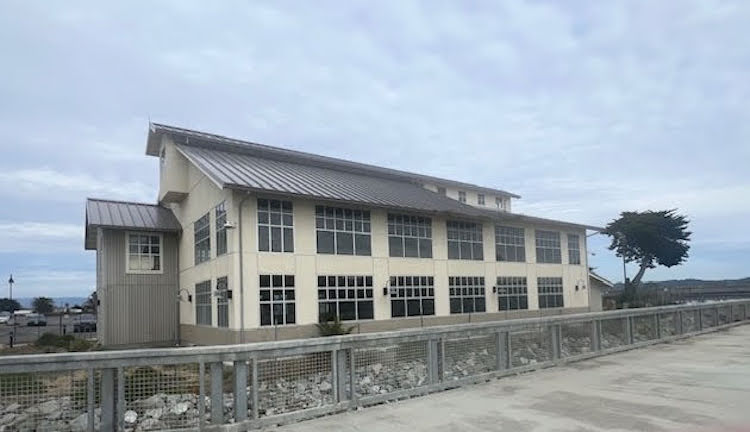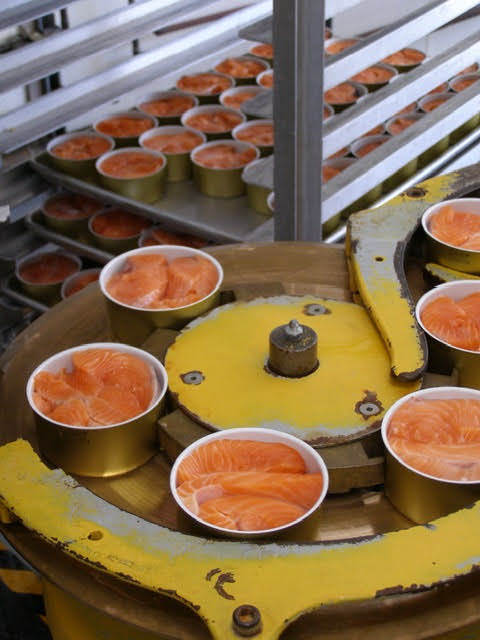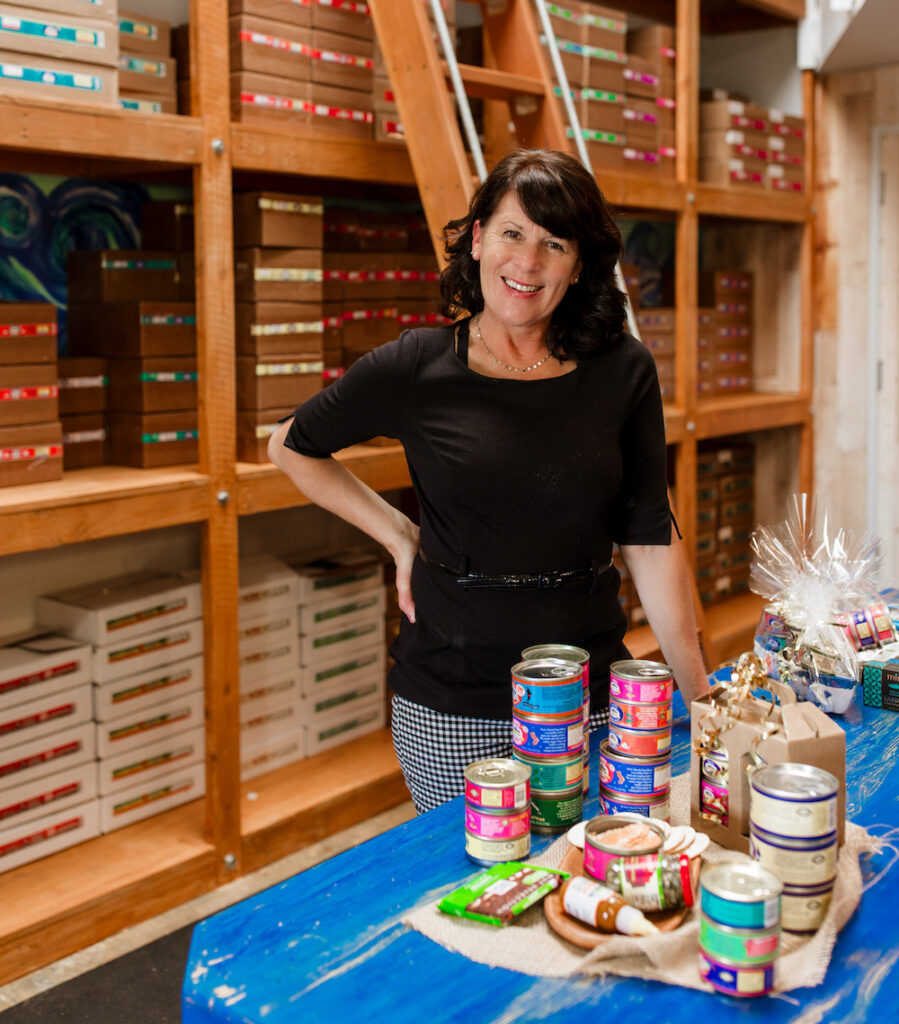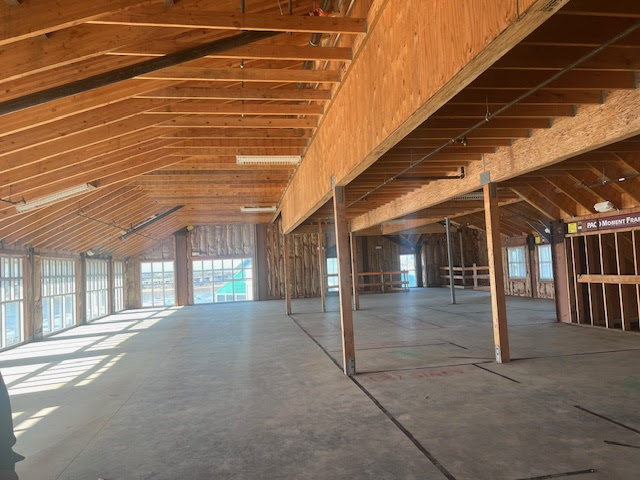
February 6, 2023 – History has a way of repeating itself.
Not this time around.
On the docks of Moss Landing, history has a real chance of reinventing itself.
It wasn’t all that long ago that Cannery Row was a row of canneries, as John Steinbeck famously wrote in the book by the same name: “Cannery Row is the gathered and scattered, tin and iron and rust and splintered wood, chipped pavement and weedy lots and junk heaps, sardine canneries of corrugated iron, honky tonks, restaurants and whore houses, and little crowded groceries, and laboratories and flophouses.”
Now Crista Jones of Dave’s Gourmet Seafood—which maintained a below-the-sonar cannery in Santa Cruz for a decade and a half and now operates a tinned fish clearing house in Watsonville—is eyeing a chance to rewrite the narrative in nonfictional fashion.
The strategy starts with a cavernous property next to Sea Harvest Restaurant & Fish Market, and involves major plans for a canning rebirth.
If the vision for Otter Bay Canning Company finds real-world expression in the coming months and years, the benefits will prove substantial.
While a number of things, including the all-important element of investment, need to materialize for that to happen, some key fundamentals are in place. More on that in a minute.

First, Dave’s Gourmet Seafood of Watsonville—which sells at the Del Monte Friday and Aptos Saturday farmers markets—merits a spotlight. (Dave’s will also start up at the Barnyard Tuesday market come summer.)
Laurel Miller has fish fans covered there, with her deep-diving feature titled “Yes, We Can: Tinned Seafood has captivated social media; does it deserve a place in your pantry?” published in EMB’s Winter issue.
“Until recently, most Americans viewed fish in a can as little more than a low-budget staple or emergency ration,” Miller writes. “In the first half of the 20th century, however, tinned seafood like sardines and anchovies was wildly popular, much of it originating in the Monterey Bay.”
The piece spotlights local doers well-versed in the craft, including Jones.
Jones’ own line of products, Miller reports, includes Pacific Northwest wild-caught sockeye, king salmon, Dungeness crab, Oregon pink shrimp, sardines and Northern Pacific albacore, all “canned fresh and cooked in their own juices.”
A thought from Jones closes the piece, along with 1) recipes for green anchovy butter and sardine bucatini, and 2) a rundown on where to acquire tinned seafood locally, with Coast Big Sur, Elroy’s Fine Foods, H&H Fresh Fish and Shopper’s Corner among the spots.
“It’s hard for consumers to trust their food supply, so we encourage them to ask questions,” Jones told Miller. “As fishermen and purveyors, it’s really important for us to be able to tell customers where their food is coming from, and how it’s caught and processed.”

As mentioned, some foundational girders have been established, beyond Dave’s ongoing success.
Those include a photo-heavy, 23-page business proposal that Jones and company have presented to the Moss Landing Harbor District Board of Commissioners, and shared with Edible.
That document outlines a build-out plan, business growth trajectory and location details, the latter noting the helpful visibility, accessibility, parking availability and strategic positioning by boat launch ramps.
It goes on to tout potential benefits of the project.
“This move aligns with our values of sustainability and innovation,” the proposal reads, “presenting a unique opportunity to contribute to conservation efforts while expanding our operations.”
The building, which has been empty for six years, is government owned. Jones pictures a production area on the bottom floor separated from a retail section by glass, allowing observation of their processing and canning operation.

“The raw space is perfect because we can set it up how we want,” Jones says.
She anticipates synergies with sport fishermen who can pick up ice and gear on the way to the adjacent ramp and consider canning their catch upon return.
Jones also imagines providing co-packing services for small farmers who have already approached Dave’s, which Jones started with namesake Dave Greenberger, who has since retired. (Meanwhile, Dave’s Gourmet will continue to partner with Pacific Northwest fishermen and canners in moving tinned fish through its Watsonville warehouse.)
The plan for phase one, if and when an estimated $400,000 of funding is in place, per Jones, would start with purchasing canning machines she has reserved to be shipped and refurbished, and would last about 8 months.
“The place could just shine,” she says. “It would be such a landmark spot. Iconic. But it takes a team to put something like this together.”
Part of that team is Moss Landing Harbor Manager and board commission member Tommy Razzecca, who was unavailable for comment by EMB’s deadline.
Another is Otter Bay project partner Cindy Ellis. She’s a longtime friend of Jones, a chicken farmer, a rescue horse caretaker, a Santa Cruz realtor and a former cannery employee as a young teen.
“I’m very into healthy eating and I love a good product,” Ellis says. “We want to bring back an old-fashioned commodity I grew up on.”
At the moment, Jones and Ellis are considering crowd-sourcing support, and are open to conversations with any potential interested investors, who are welcome to message info@davesgourmetseafood.com.
Ellis adds another note, and one that feels appropriate as Otter Bay flirts with a way to bring Monterey Bay back around to a local tradition.
“What excites me about this project is the end idea is to provide healthy fish for customers, but also build out a bone mill that takes fish scraps, crushes it up and becomes great feed for chickens and a very, very good amendment for your soil,” she says. “We’re going to be full circle.”

Steinbeck called Cannery Row “a poem, a stink, a grating noise, a quality of light, a tone, a habit, a nostalgia, a dream.”
For now, the proposed possibility of Sea Otter Canning Company can be called an aspiration, a beacon and a synergistic dream.
Here’s hoping it also becomes a reality, a bit of history relaunched into a thoughtful and flavor-forward future.
More at davesgourmetseafood.com.
About the author
Mark C. Anderson, Edible Monterey Bay's managing editor, appears on "Friday Found Treasures" via KRML 94.7 every week, a little after 12pm noon. Reach him via mark@ediblemontereybay.com.
- Mark C. Andersonhttps://www.ediblemontereybay.com/author/markcanderson/
- Mark C. Andersonhttps://www.ediblemontereybay.com/author/markcanderson/
- Mark C. Andersonhttps://www.ediblemontereybay.com/author/markcanderson/
- Mark C. Andersonhttps://www.ediblemontereybay.com/author/markcanderson/



